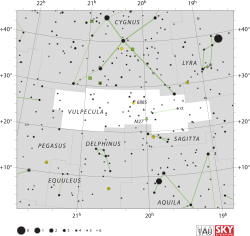24 Vulpeculae
| 24 Vulpeculae | |
 | |
| Observationsdata Epok: J2000.0 | |
|---|---|
| Stjärnbild | Räven |
| Rektascension | 20t 16m 47,08593s[1] |
| Deklination | +24° 40′ 15,9624″[1] |
| Skenbar magnitud () | +5,30 (V)[2], +5,302 ± 0,009[3] |
| Stjärntyp | |
| Spektraltyp | G8 III[2] |
| B–V | 0,951 ± 0,001[4] |
| Astrometri | |
| Radialhastighet () | 15,3 ± 0,3[5] km/s |
| Egenrörelse (µ) | RA: 14,52[1] mas/år Dek.: -17,12[1] mas/år |
| Parallax () | 7,45 ± 0,27[1] |
| Avstånd | 440 ± 20 lå (134 ± 5 pc) |
| Absolut magnitud () | -0,68[2] |
| Detaljer | |
| Massa | 3,41[2] M☉ |
| Radie | 16[6] R☉ |
| Luminositet | 191[2] L☉ |
| Temperatur | 4 981[2] K |
| Metallicitet | -0,06 (Fe/H)[2] dex |
| Vinkelhastighet | 5,02[7] km/s |
| Ålder | 251[2] miljoner år |
| Andra beteckningar | |
| HD 192944[8], HIP 99951[8], HR 7753[8], IRAS 20146+2430[8], 2MASS J20164707+2440159[8], SAO 88451[8], GSC 02159-02069[8], 1RXS J201647.3+244011[8], BD+24 4075[8], FK5 760[8], GC 28183[8], GCRV 12654[8], HIC 99951[8], N30 4480[8], PLX 4828[8], PLX 4828.00[8], PPM 110800[8], ROT 2951[8], SRS 30760[8], TYC 2159-2069-1[8], YZ 24 7607[8], WEB 17985[8], Gaia DR2 1832206046035389696[8], 24 Vul, Gaia DR3 1832206046035389696[8], TIC 88003319[8] och AG+24 2166[8][9] | |
24 Vulpeculae, som är stjärnans Flamsteed-beteckning, är en ensam stjärna[10] belägen i den mellersta delen av stjärnbilden Räven. Den har en skenbar magnitud på ca 5,30[2] och är svagt synlig för blotta ögat där ljusföroreningar ej förekommer. Baserat på parallaxmätning inom Hipparcosuppdraget på ca 7,5[1] mas, beräknas den befinna sig på ett avstånd på ca 440 ljusår (ca 134 parsek) från solen. Den rör sig bort från solen med en heliocentrisk radialhastighet av ca 15 km/s.[5]
Egenskaper
24 Vulpeculae är en gul till vit jättestjärna av spektralklass G8 III,[7] som har förbrukat förrådet av väte i dess kärna och utvecklats bort från huvudserien. Den ingår nu i röda klumpen och befinner sig på horisontella jättegrenen och genererar energi genom termonukleär fusion av helium i dess kärna.[11] Den har en massa som är ca 3,4[2] solmassor, en radie som, baserat på en interferometrimätt vinkeldiameter av 1,08 ± 0,02 mas,[12] är ca 16[6] solradier och utsänder ca 191[2] gånger mera energi än solen från dess fotosfär vid en effektiv temperatur på ca 5 000 K.[2] Stjärnan är med 99,4 procent sannolikhet källa till röntgenstrålning som observerats från dess position.[13]
Referenser
- Den här artikeln är helt eller delvis baserad på material från engelskspråkiga Wikipedia, 24 Vulpeculae, 18 september 2020.
Noter
- ^ [a b c d e f] van Leeuwen, F. (2007), "Validation of the new Hipparcos reduction", Astronomy and Astrophysics, 474 (2): 653–664, arXiv:0708.1752, Bibcode:2007A&A...474..653V, doi:10.1051/0004-6361:20078357.
- ^ [a b c d e f g h i j k l] Takeda, Yoichi; et al. (August 2008), "Stellar Parameters and Elemental Abundances of Late-G Giants", Publications of the Astronomical Society of Japan, 60 (4): 781–802, arXiv:0805.2434, Bibcode:2008PASJ...60..781T, doi:10.1093/pasj/60.4.781.
- ^ ”Basic data: V* 24 Vul – Star” (på engelska). Centre de Données astronomiques de Strasbourg. http://simbad.u-strasbg.fr/simbad/sim-basic?Ident=24+Vul&submit=SIMBAD+search. Läst 7 juli 2019.
- ^ van Leeuwen (2007). ”Hipparcos, the New Reduction” (på engelska). http://vizier.u-strasbg.fr/viz-bin/VizieR-5?-out.add=.&-source=I/311/hip2&HIP=99951. Läst 7 juli 2019.
- ^ [a b] Gontcharov, G. A. (2006), "Pulkovo Compilation of Radial Velocities for 35 495 Hipparcos stars in a common system", Astronomy Letters, 32 (11): 759, arXiv:1606.08053, Bibcode:2006AstL...32..759G, doi:10.1134/S1063773706110065.
- ^ [a b] Lang, Kenneth R. (2006), Astrophysical formulae, Astronomy and astrophysics library, 1 (3rd ed.), Birkhäuser, ISBN 3-540-29692-1. The radius (R*) is given by::
- ^ [a b] Hekker, S.; Meléndez, J. (2007), "Precise radial velocities of giant stars. III. Spectroscopic stellar parameters", Astronomy and Astrophysics, 475 (3): 1003–1009, arXiv:0709.1145, Bibcode:2007A&A...475.1003H, doi:10.1051/0004-6361:20078233.
- ^ [a b c d e f g h i j k l m n o p q r s t u v w x y z] SIMBAD Astronomical Database.[källa från Wikidata]
- ^ "24 Vul". SIMBAD. Centre de données astronomiques de Strasbourg. Hämtad 2018-04-21.
- ^ Eggleton, P. P.; Tokovinin, A. A. (September 2008), "A catalogue of multiplicity among bright stellar systems", Monthly Notices of the Royal Astronomical Society, 389 (2): 869–879, arXiv:0806.2878, Bibcode:2008MNRAS.389..869E, doi:10.1111/j.1365-2966.2008.13596.x.
- ^ Valentini, M.; Munari, U. (November 2010), "A spectroscopic survey of faint, high-Galactic-latitude red clump stars. I. The high resolution sample", Astronomy and Astrophysics, 522: A79, arXiv:1007.0207, Bibcode:2010A&A...522A..79V, doi:10.1051/0004-6361/201014870.
- ^ Richichi, A.; et al. (February 2005), "CHARM2: An updated Catalog of High Angular Resolution Measurements", Astronomy and Astrophysics, 431: 773–777, Bibcode:2005A&A...431..773R, doi:10.1051/0004-6361:20042039
- ^ Haakonsen, Christian Bernt; Rutledge, Robert E. (September 2009), "XID II: Statistical Cross-Association of ROSAT Bright Source Catalog X-ray Sources with 2MASS Point Source Catalog Near-Infrared Sources", The Astrophysical Journal Supplement, 184 (1): 138–151, arXiv:0910.3229, Bibcode:2009ApJS..184..138H, doi:10.1088/0067-0049/184/1/138.






